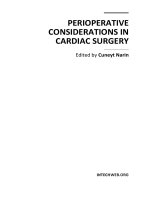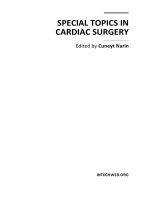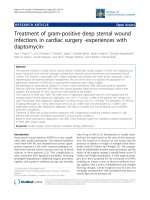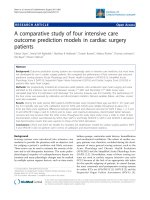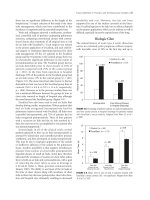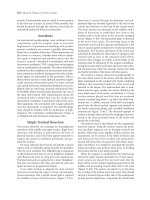Ebook Reoperations in cardiac surgery: Part 1
Bạn đang xem bản rút gọn của tài liệu. Xem và tải ngay bản đầy đủ của tài liệu tại đây (13.22 MB, 199 trang )
J. Stark and A.D. Pacifico (Eds.)
Illustrations by M. Courtney
Reoperations in
Cardiac Surgery
Foreword by David C. Sabiston, Jr
With 388 Figures
Springer-Verlag
London Berlin Heidelberg New York
Paris Tokyo Hong Kong
Jaroslav Stark, MD, FRCS, FACS
Consultant Cardiothoracic Surgeon, The Hospital for Sick Children, Great
Ormond Street, London WCIN 3JH, UK.
Albert D. Pacifico, MD
Professor and Director, Division of Cardiothoracic Surgery, University of
Alabama at Birmingham, University Station, Birmingham, Alabama 35294,
USA.
ISBN-13:978-1-4471-1690-5
e-ISBN-13:978-1-4471-1688-2
DOl: 10.1007/978-1-4471-1688-2
British Library Cataloguing in Publication Data
Reoperations in cardiac surgery.
I. Man. Heart. Surgery
I. Stark, J. (Jaroslav), 1934II. Pacifico, A.D.(Albert D.)
617'.412
ISBN-13:978-1-4471-1690-5
Library of Congress Cataloging-in-Publication Data
Stark,·J. (Jaroslav)
Reoperations in cardiac surgery / J. Stark and A.D. Pacifico
(eds.) ; foreword by D. Sabiston
p.
cm.
Includes bibliographies and index.
ISBN 0-387-19552-1
1. Heart-Reoperation. 2. Congenital heart disease-Reoperation.
I. Pacifico, Albert D. II. Title.
[DNLM: I. Heart Surgery. 2. Surgery. Operative. WG 169 S795r)
RD598.35.R46S73 1989
617' .4 12--dc19
DNLMIDLC
89-6080
for Library of Congress
CIP
This work is subject to copyright. All rights are reserved, whether the whole or part of the material is
concerned, specifically the rights of translation, reprinting, reuse of illustrations, recitation. broadcasting,
reproduction on microfilms or in other ways, and storage in data banks. Duplication of this publication or
parts thereof is only permitted under the provisions of the German Copyright Law of September 9, 1965,
in its version of June 24, 1985, and a copyright fee must always be paid. Violations fall under the prosecution
act of the German Copyright Law.
© Springer-Verlag Berlin Heidelberg 1989
Softcover reprint of the hardcover 1st edition 1989
The use of registered names, trademarks etc. in this publication does not imply, even in the absence of a
specific statement, that such names are exempt from the relevant laws and regulations and therefore free
for general use.
Product Liability: The publisher can give no guarantee for information about drug dosage and application
thereof contained in this book. In 'every individual case the respective user must check its accuracy by
consulting other pharmaceutical literature.
Filmset by Photographics, Honiton, Devon
2128/3916-543210 (Printed on acid-free paper)
Foreword
Nearly a century has passed since Rehn performed the first successful cardiac
operation by closing a right ventricular stab wound in a gravely ill patient.
Moreover, it has been more than fifty years since Gross successfully corrected the
first congenital cardiac malformation in 1938 by suture ligation of a patent ductus
arteriosus. The introduction of the Blalock operation for tetralogy of Fallot by
Blalock in 1944 greatly advanced the management and prognosis of a critically ill
group of cardiac patients, and the success of this procedure further stimulated the
development of concepts and techniques for the surgical management of other
severe congenital cardiac defects. Until the successful use of extracorporeal
circulation by Gibbon in 1953, it was often necessary to perform cardiac operations
which were palliative rather than curative procedures. With the advent of additional
new and improved techniques, correction of many hitherto incurable cardiac
disorders became possible and reoperation under these circumstances became
frequent.
Cardiac surgery is very fortunate in having two master surgeons, whose distinctive
contributions and clinical proficiency are recognized worldwide, to edit this
extraordinary and unique text. They have placed emphasis on a number of specific
complications of primary cardiac procedures which lead to the necessity for
reoperation. Problems associated with postoperative infections, thrombotic disorders, stenoses of suture lines, deterioration of prosthetic materials and mechanical
valves, rejection of transplanted organs and tissues, and a host of additional
complications are described together with their appropriate surgical management.
The ·Editors have selected 14 other authorities in both acquired and congenital
disease to record their experiences and solutions to these vexing problems.
The initial chapters concern the necessity to obtain preoperatively as much
information as possible on the cardiac lesions requiring correction. Specific attention
is given to the roles of angiocardiography, digital subtraction angiography, cardiac
catheterization, echocardiography, chest roentgenography, computed transaxial
tomographic scanning (CT), magnetic resonance imaging, electrocardiography, and
other appropriate techniques. The authors deserve special commendation for the
thoroughness found in each section as well as the excellence of the illustrations
which depict the stepwise correction of the various problems. Similarly, examples
of the diagnostic studies are beautifully reproduced with their significant features
being made obvious to the reader. Each subject is carefully referenced with a
select and up-to-date bibliography. It is apparent that the authors have given each
subject maximal thought and attention in the preparation of this very laudable
text. Each of the common cardiac procedures is included as are a number of less
frequently encountered but nevertheless very significant problems requiring
vi
Foreword
reoperation. The reader is particularly struck with the obvious familiarity of each
contributor with the subject presented, which provides gratifying confidence to
those undertaking these reoperations.
In summary, Reoperations in Cardiac Surgery is a very timely contribution edited
by two of the most renowned contemporary cardiac surgeons with additional
contributors of similar stature. Of maximal current significance, this masterwork
will predictably become a widely used and frequently cited reference as well as an
essential part of the library of all cardiac surgeons.
May 1989
David C. Sabiston, Jr
Preface
More cardiac operations are performed each year. The incidence of reoperations
is also increasing. There are several reasons for this increase: failure of mechanical
and biological valve substitutes, conduits and coronary bypass grafts, erroneous
diagnosis, incomplete repair and infection. In surgery of congenital heart defects
replacement of the original prosthetic valve is required if the child outgrows the
prosthesis. Reoperation may also be part of a staged repair for a complex lesion
or may be required for residual or recurring defects.
The purpose of this book is to provide information about the diagnosis of early
and late complications, the indications for reoperation and the optimal timing of
reoperation. The main emphasis is on the description of safe surgical techniq"ues.
The book is divided into three sections. The general part includes chapters on
diagnosis, anaesthesia, surgical approaches to the heart and great vessels,
reoperations in the presence of infection, postoperative mediastinitis, pacemakers,
and heart and heart-lung transplantation. The second section describes surgical
techniques used for reoperations of congenital heart defects. All common defects
are included. To avoid repetition and too lengthy text some combinations of lesions
are not discussed separately. They are described either in the congenital or the
acquired heart defect section although they can have both aetiologies. The third
section on acquired heart disease includes chapters on. coronary arteries, mitral
and tricuspid valves, arrhythmia and thoraco-abdominal aneurysms.
The authors describe the techniques which gave them, over the years, the best
results. Some alternatives are mentioned without an attempt to cover all published
techniques. The text relies on Michael Courtney's illustrations. He worked very
closely with the Editors and was able to transform sketches made by individual
authors into instructive three-dimensional illustrations. With a few exceptions all
drawings are oriented as the heart is seen by the operating surgeon.
This book should provide information to a young surgeon who does not have a
large experience with reoperations. We hope that it will also be useful to established
surgeons, especially in the chapters on the less common lesions or complications.
It may also be of interest to cardiologists, cardiac anaesthetists, radiologists,
intensive care personnel and nurses. We believe that a well-performed original
operation will lead to a minimal number of complications. However, when residual
or recurring defects cause haemodynamic problems, correctly timed and expertly
performed reoperations may return the patient to normal health and an active life.
We hope that the book will contribute to this goal.
J. Stark, MD, FRCS, FACS
Consultant Cardiothoracic Surgeon
A.D. Pacifico, MD
Director, Division of Cardiothoracic Surgery
Acknowled2ements
We would like to express our thanks to Dr. G.R. Graham, former Clinical
Physiologist at The Hospital for Sick Children, Great Ormond Street, for his
suggestion to write this book. Our thanks are due to all the contributors for
preparing the text, for allowing considerable e~itorial changes to achieve uniformity
and for their co-operation in working with one artist.
Michael Courtney made a great contribution to this book. His clear understanding
of the points we wanted to illustrate and his ability to transfer them into highquality illustrations will, we hope, be appreciated by the readers.
Our thanks are due to our secretaries, Miss. V. Parkhouse, Miss. P. Hunter,
and especially Mrs. S. Croot, Research Secretary in the Cardiothoracic Unit at
The Hospital for Sick Children, Great Ormond Street, who has helped with the
collection of the material, researched literature, and edited and transcribed all the
manuscripts.
March 1989
J. Stark, MD, FRCS, FACS
Consultant Cardiothoracic Surgeon
A.D. Pacifico, MD
Director, Division of Cardiothoracic Surgery
Contents
Contributors. .. . .. . . .. . .. . .. .. . . .. . . . . .. .. . . .. . . . .. . . . . . . . . .. . . . .. . . . .. . . . . . . . ... .. . . . . . . . . . ... . . .. xix
Abbreviations ..................................................................................... xxiii
Section I: General
1
2
Investigation Before Reoperations for Congenital Heart Disease
1. F. N. Taylor...............................................................................
3
Introduction.. .. ... . . . .. .. . . .. . .. . .. .. . . . . .. .. .. .. . . .. . . . . .. .. . . . ... . .. . .. . . . . . .. . . . .. .. .. . ..
Staged Procedures.........................................................................
Residual Lesions...........................................................................
Clinical Considerations...............................................................
Non-~nvasive I~ves.tigation ..........................................................
Invasive Investigation..................................... ................... .........
Recurrent Lesions.........................................................................
Changes Resulting from Growth, and Deterioration in Prosthetic
Function............................................ .... ........ ..............................
Prognosis After Completion of Intended Management........................
Conclusion ........ :..........................................................................
3
4
5
5
8
10
13
Investigations Before Reoperation for Acquired Heart Disease
Celia M. Oakley...........................................................................
Introduction.. . . . ... . . .. .. .. .. . .. . .. .. .. . . .. ... . . . . . . . .. .. . . . . .. . .. . . . . . . . . . . . . . . . . . . . .. . .. . .
Methods of Investigation................................................................
Non-invasive Investigation ................ ..........................................
Invasive Investigation.................................................................
Reasons for Failure of Previous Operations.......................................
Wrong Indication or Wrong Operation.... ........................ ..............
Valve Disease...........................................................................
After Pericardiectomy................................................................
Special Problems ....................................................,................. ;....
The Myocardium.......................................................................
Marfan's Syndrome....................................................................
Myxoma and Other Cardiac Tumours...........................................
Pregnancy ................................................................................
Traumatic Heart Disease............................................................
Emergencies ................................................................................
14
15
16
17
17
17
17
18
19
19
19
25
26
26
27
27
28
29
29
x
3
4
Contents
Mechanical Disasters..................................................................
Prosthetic Valve Thrombosis "Encapsulation" ................................
Infective Endocarditis ........ ..... .............................. .....................
Reoperation After Previous Coronary Bypass Surgery.........................
Pericardial Syndromes ...................................................................
Postoperative Pericardial Collection..............................................
Conclusion ......................................................... , .........................
29
30
31
33
35
35
35
Anaesthesia for Cardiac Reoperations
M. Scallan...................................................................................
Introduction. . .. . . . . . . . . .. .. .. ... . . . . . . . . .. . . . . . . .. . . .. .. ... . . . . . .. . .. . . . . . . . . .. . .. . . . .. .. . . .
Preoperative Assessment................................................................
Anaesthesia. .. . . ... .. .. ... . . . .. . .. . . .. . . . . . . . .. ... ... . . . ... .... . ... . . . .. ... . . .. . . .. . . . .. . . .. .
Monitoring ..................................................................................
Specific Conditions........................................................................
Reoperation for Coronary Artery Bypass Grafts.............................
Valvar Heart Disease .................................................................
Congenital Heart Disease...........................................................
Postoperative Complications...........................................................
Conclusion...................................................................................
39
39
39
40
40
41
41
41
42
42
42
Approaches to the Heart and Great Vessels at Reoperation
J. Stark ................................................. ...................................... 43
Introduction. .. . . .. . . . .. ... . . ... . .. . . ... .. . . . . .. .. . . . . .. .. . . . . .. ... . . . . . .. . . . . . .. . . . . . .. . .. . .
Sternal Re-entry...........................................................................
Prevention ................................................................................
Operative Technique................................ ........................ ..........
Results ....................................................................................
Re-thoracotomy ........................ ................ ........ .................... ........
Conclusion...................................................................................
5
6
Reoperations in the Presence of Infection
L. H. Cohn............................................................ ..... .... ..............
Introduction. . .. . .. . . . . . .. .. .. . .. . .. . . .. . .. . . . . . . . . . . . . . . .. . .. . . . ... .. .. . .. . . . . . . . . . . . .. . . . . .
General Considerations..................................................................
Indications for Surgery..................................................................
Prosthetic Valve Endocarditis......................................................
Infected Aortocoronary Bypass.... ................................................
Infected Cardiac Suture Line................................ .......................
Surgical Technique........................................................................
Reoperation in the Presence of Infected Prosthetic or Bioprosthetic
Valves .....................................................................................
Surgical Technique for the Infected Cardiac Suture Line..................
Surgical Treatment of Infected Coronary Bypass Graft....................
Results ........................................................................................
Conclusions and Summary..............................................................
43
44
44
45
51
51
52
55
55
55
56
56
57
57
58
58
64
64
65
66
Pacing: Indications, Technique of Insertion and Replacement of Leads
and Generators
P. G. Rees.................................................................................... 67
Introduction ....................................... '.. ... . . . .. . .. . . . . . . .. . . . .. . . ... .. . . ... .. . . . 67
Description of Generators ............ 1.............................................. 67
Contents
Indications for Permanent Pacemaker Insertion..................................
Choice of Pacing Systems...............................................................
Generator ...................... , ......... '" .. ... . .. .. . . .. .. ... .. .. . .. ... . .... .. . . ... ... .
Wire .......................................................................................
Pacing .........................................................................................
Temporary.. ... .. .. . ... ... ... . . .. . .. . . . .. . ... .. .. .. .. . . .. . . .. ... .. .. .. . .. .. .. . .. . ... .. ...
Permanent ...............................................................................
Generator Implantation .............. "...................................................
Pectoral/Axillary Approach.........................................................
Subxiphoid Approach.................................................................
Suprarenal Approach.................................................................
Reoperation. .. . . .. . . .. .... .. ... . .. .. ... . .. .. . . .. . . . . .. . . .. . . .. .. ... .. . . . . .. .. ... .. . . . .. . ... .
Pulse Generator Replacement .....................................................
Pacemaker Lead Problems..........................................................
Pacemaker System Replacement for Infection................................
Follow-up....................................................................................
Restrictions .......................................................................... ,. ..
Conclusion...................................................................................
7
8
Postoperative Mediastinitis
P.F. Sauer and L.O. Vasconez .............................................. ..........
Introduction.................................................................................
Aetiology....................................................................................
Bacteriology............ ................ ............ ............. ... ..................... ....
History of Management Options......................................................
Sternal Blood Supply ...................................................... "...............
Reconstructive Options..................................................................
Omentum ................................................................................
Pectoralis Major........................................................................
Rectus Abdominis.....................................................................
Complications ..............................................................................
Mediastinitis in Infants and Children...... ....................................... ...
Conclusions............................ .....................................................
xi
68
69
69
70
71
71
71
75
76
76
76
77
77
78
78
78
79
80
81
81
81
81
82
82
83
83
85
86
88
90
90
Heart and Lung Retransplantation
M.R. Mill and E.B. Stinson ............................................... ............. 93
Cardiac Retransplantation ............................................................. 93
Introduction ......................................... , ... " ............ , ... .. . . ... . . .. .. .. .. .
Indications for Retransplantation.....................................................
Technique of Retransplantation.......................................................
Postoperative Care........................................................................
Results at Stanford University Hospital ..................................... ;......
Summary .....................................................................................
93
93
93
98
98
99
Heart-Lung Retransplantation ........................................................ 100
Introduction .................................................................................
Indications for Retransplantation .....................................................
Technique of Retransplantation .......................................................
Postoperative Care ........................................................................
Results ........................................................................................
Summary .....................................................................................
100
100
100
102
102
103
xii
Contents
Section II: Congenital Heart Disease
9
Reoperations After Repair of Coarctation of the Aorta
J. Stark ....................................................................................... 107
Introduction ................................................................................. 107
Problems Following Repair of Coarctation ........................................ 107
Residual/Recurrent Coarctation (Re-coarctation) ............................ 108
Aneurysm/Pseudoaneurysm ......................................................... 109
Chylothorax ... ;- ......................................................................... 110
Phrenic Nerve Palsy ................................................................... 111
Vocal Cord Palsy ...................................................................... 111
Systemic Hypertension ............................................................... 111
Operative Technique ................ ;.................................................... 112
Re-coarctation ...............................c••••••••••••••••••••••••••••••••••••••••••• 112
. Repair of Aneurysm/Pseudoaneurysm ........................................... 120
Results ........................................................................................ 120
Residual/Recurrent Coarctation of the Aorta ................................. 120
Aneurysm/Pseudoaneurysm .......................................................... 121
10
Reoperations for Interrupted Aortic Arch
J.L. Monro ............. ..................................................................... 125
Introduction .................................................................. " ............. 125
Problems ..................................................................................... 126
Stenosis of the Aortic Anastomosis .............................................. 126
Subvalvar Stenosis ..................................................................... 127
Valvar Stenosis ......................................................................... 127
Supravalve Stenosis ................................................................... 127
Residual VSD ........................................................................... 127
Previous Palliation ..................................................................... 127
Operative Techniques .................................................................... 127
Techniques for First Operation .................................................... 127
Technique for Reoperation ......................................................... 131
Postoperative Care ........................................................................ 136
Results ........................................................................................ 136
Conclusion ................................................................................... 140
11
Reoperations After Repair of Total Anomalous Pulmonary Venous
Connection
D.l. Hamilton and H.J. CM. van de Wal ..........................................
Introduction ...................................................... ;..........................
Problems .....................................................................................
Complications Requiring Medical Management. ..............................
Complications Requiring Surgical Management. ..............................
Surgical Technique ........................................................................
Original Operation ....................................................................
Reoperation .............................................................................
Postoperative Management .............................................................
Results ........................................................................................
Early Results - Mortality After the Primary Operation ....................
Late Deaths Following the Primary Operation ...............................
143
143
143
144
145
151
151
154
158
158
158
158
Contents
xiii
12
Reoperations After Closure of Ventricular Septal Defects
M.R. de Leval.................................... ..........................................
Introduction .................................................................................
Problems .....................................................................................
Residual or Recurrent Intracardiac Shunt.. ....................................
Arterial Valve Damage ..............................................................
Atrioventricular Valve Dysfunction ..............................................
Outflow Tract Obstructions .........................................................
Haemolysis ...............................................................................
Postoperative Bacterial Endocarditis .............................................
Conduction Disturbances ............................................................
Surgical Techniques .......................................................................
Residual/Recurrent Intracardiac Shunts ........ : ................................
Additional VSDs .......................................................................
Aortic Valve Regurgitation .........................................................
Atrioventricular Valve Dysfunction ..............................................
Outflow Tract Obstructions .........................................................
Haemolysis ...............................................................................
Endocarditis .............................................................................
Pacemaker Insertion ..................................................................
Postoperative Care ........................................................................
161
161
161
161
163
163
163
164
164
164
165
165
166
167
168
168
169
169
169
169
13
Reoperations After Repair of Tetralogy of Fallot
A.D. Pacifico ................................................ ...............................
Introduction .................................................................................
Problems, Diagnosis and Indication for Reoperation ...........................
Residual or Recurrent VSD ........................................................
Residual RVOTO .....................................................................
Pulmonary Insufficiency ..............................................................
Tricuspid Valve Insufficiency .......................................................
Right Ventricular Aneurysm .......................................................
Residual ASD ..........................................................................
Residual Surgical Shunt ..............................................................
Surgical Technique ........................................................................
Repair of Residual or Recurrent VSD ..........................................
Repair of RVOTO ....................................................................
Repair of Pulmonary Insufficiency ................................................
Repair of Tricuspid Valve Insufficiency .........................................
Repair of Right Ventricular Aneurysm .........................................
Repair of ASD .........................................................................
Repair of Residual Surgical Shunt.. ..............................................
Postoperative Care ........................................................................
Results ........................................................................................
171
171
174
174
175
175
176
176
177
177
177
177
179
182
182
183
183
183
183
183
14
Reoperations After Mustard and Senning Operations
J. Stark ......................................... ...............................................
Introduction .................................................................................
Problems ......................................................................................
Mustard Operation ....................................................................
Senning Operation .....................................................................
Operative Technique .....................................................................
187
187
188
188
192
194
xiv
Contents
Mustard ................................................................................... 194
Senning ................................................................................... 201
Results of Reoperations After Mustard or Senning Procedures ............. 205
15
Reoperations After Arterial Switch Operation
A.R. Castaneda ............................................................................ 209
Introduction .. " .................................................... " ....................... 209
Complications .............................................................................. 209
Surgical Technique ........................................................................ 211
Original Operation .................................................................... 211
Reoperation .......................................................................... , .. 213
Results ............................................ : ........................................... 214
16
Arterial Switch for Right Ventricular Failure Following Mustard or
Senning Operations
R.B.B. Mee ................................................................................. 217
Introduction ................................................................................. 217
Problems ..................................................................................... 218
Related to Previous Atrial Repair ................................................ 218
Related to the Concept of Atrial Repair. ...................................... 219
Management and Surgical Technique ............................................... 220
Stage I. Pulmonary Artery Banding for RV Failure After Mustard/
Senning ................................................................................... 220
Stage II. Conversion of Mustard/Senning to Arterial Switch ............. 223
17
Aortic Valve Reoperations
A.D. Pacifico ................................................ ............................... 233
Introduction ...................................... " .. " .............................. " ... " 233
Secondary Aortic Valvotomy for Congenital Valvar Aortic Stenosis ...... 233
Problems ................................................................................. 233
Indication for Reoperation .......................................................... 234
Surgical Technique ..................................................................... 234
Postoperative Care .............................................. ;..................... 237
Results .................................................................................... 237
Secondary Aortic Valve Replacement. .............................................. 238
Problems ................................................................................. 238
Indications for Reoperation ......................................................... 238
Operative Technique .................................................................. 238
Postoperative Care .................................................................... 243
Results .................................... ~ ................................... " ... " ..... 243
Enlargement of the Small Aortic Annulus ......................................... 244
Problems and Indications for Reoperation ..................................... 244
Operative Technique .................................................................. 245
Results .................................................................................... 246
18
Reoperations for Residual/Recurrent Left Ventricular Outflow Tract
Obstruction
P.A. Ebert ...................................................................................
Introduction ..... '" ............... , " ....... " ...... , .............. " .......................
Problems Following Initial Aortic Valvotomy ....................................
Residual/Recurrent Aortic Stenosis ...............................................
249
249
249
249
Contents
xv
Aortic Insufficiency ................................................................... 250
Coronary Artery Insufficiency ..................................................... 250
Supravalvar Aortic Stenosis ......................................................... 250
Subvalvar Aortic Stenosis ........................................................... 250
Problems Following Operative Repair of Subvalvar Aortic Stenosis ....... 250
Conduction Problem ................................................................... 250
Aortic Valve Injury ................................................................... 250
Mitral Valve Injury ................................................................... 251
Ventricular Rupture ................................................................... 251
Diagnosis and Evaluation ................................................................ 251
Operative Technique ..................................................................... 251
Konno Aortoventriculoplasty ....................................................... 252
Left Ventric1e to Aorta Conduit .................................................. 255
Postoperative Management ............................................................. 256
Results ........................................................................................ 256
19
20
Aortic Root Replacement
D.N. Ross and Roxane McKay .......................................................
Introduction .................................................................................
Indications for Reoperation ............................................................
Left Ventricular Outflow Tract Obstruction ...................................
. Aortic Regurgitation ..................................................................
Structural Defects ......................................................................
Endocarditis .............................................................................
Operative Technique of Aortic Root Replacement .............................
General Considerations ..............................................................
Homograft Replacement of the Aortic Root.. ................................
Reoperation After Homograft Aortic Root Replacement .................
Postoperative Management .............................................................
Results ........................................................................................
259
259
260
260
261
261
262
262
263
265
268
268
269
Reoperations in Patients with Extracardiac Valved Conduits
J. Stark ....................................................................................... 271
Introduction ................................................................................. 271
Problems ..................................................................................... 271
Complications Related to Conduit Insertion ................................... 272
Complications Unrelated to Conduit Insertion ................................ 276
Operative Technique ..................................................................... 278
General ................................................................................... 278
Sternal Re-entry, Re-thoracotomy and Cannulation ......................... 279
Conduit Replacement ................................................................. 280
Replacement of Systemic (Tricuspid) Atrioventricular Valve in
Patients with Congenitally Corrected Transposition ......................... 284
Truncal Valve Incompetence ....................................................... 284
Recurrent/Residual VSD ............................................................ 284
Conduit or Ventricular Aneurysm/Pseudoaneurysm ......................... 285
Recurrent/Residual Left Ventricular Outflow Tract Obstruction ........ 285
Residual/Recurrent Pulmonary Branch Stenoses ............................. 286
Residual/Recurrent Major Aortopulmonary Collaterals .................... 287
Infection .................................................................................. 287
Postoperative Care ........................................................................ 287
Results ........................................................................................ 288
xvi
Contents
21
Reoperations After the Fontan Procedure
F. Fontan, G. Fernandez and 1. Stark .............................................. 291
Introduction ................................................................................. 291
Diagnosis of Problems and Indications for Reoperation ....................... 291
Early Problems ......................................................................... 291
Late Problems .......................................................................... 293
Surgical Techniques/Treatment ........................................................ 295
Early Problems ......................................................................... 295
Late Problems .......................................................................... 298
Postoperative Care ........................................................................ 302
Results ........................................................................................ 303
22
Reoperations for Atrioventricular Discordance
M. R. de Leval.............................................................................. 305
Introduction ................................................................................. 305
Problems ..................................................................................... 305
Recurrent or Increasing LVOTO ................................................. 305
Residual/Recurrent VSDs ........................./.................................. 306
Systemic Atrioventricular Valve Regurgitation and Systemic
Ventricular Failure .................................................................... 306
Conduction Disturbances ............................................................ 307
Surgical Considerations .................................................................. 307
Anatomical Landmarks .............................................................. 307
Surgical Techniques ....................................................................... 309
Postoperative Care ........................................................................ 311
Results ........................................................................................ 311
Section III: Acquired Heart Disease
23
Reoperations for Coronary Artery Disease
D.M. Cosgrove, III and F.D. Loop ................................................. 315
Incidence ..................................................................................... 315
Indications for Reoperation ............................................................ 316
Surgical Technique ........................................................................ 317
Results ........................................................................................ 322
Conclusions ................................................................................. 322
24
Reoperations on the Mitral and Tricuspid Valves
C.G. Duran ....................................................... .......................... 325
Mitral Valve ............................... : ................................................ 325
Introduction ................................ '................................................. 325
Problems ...................................................... " ............................. 326
Mitral Valve Conservative Surgery...................................................
Causes and Incidence of Re-stenosis .............................................
Causes and Incidence of Residual/Recurrent Regurgitation ...............
Diagnosis of Valve Malfunction and Timing of Reoperation .............
326
326
328
330
Mitral Valve Replacement. ............................................................. 331
Surgical Technique .................................................................... 331
xvii
Contents
Prosthesis-related Problems .........................................................
Patient -related Problems .............................................................
Operative Technique:Access to Mitral Valve ..................................
Operative Technique: Surgery After Mitral Reconstruction ..............
Operative Technique: Valve Re-replacement ..................................
332
333
334
338
340
Tricuspid Valve ............................................................................ 343
Introduction ................................................................................. 343
Problems ..................................................................................... 344
Tricuspid Problems Overlooked During the Original Operation ......... 344
After Commissurotomy and Annuloplasty ..................................... 344
After Tricuspid Valve Replacement.. ............................................ 345
Operative Technique ..................................................................... 345
Access to Tricuspid Valve ........................................................... 345
Reoperation on Triscuspid Valve ................................................. 346
Postoperative Care ........................................................................ 347
Results ........................................................................................ 347
25
26
Reoperations in the Surgical Treatment of Arrhythmias
1.K. Kirklin .... ............................................................................ 351
Reoperations for WPW .. . . .. . . . . . . .. . ..................................................
Diagnosis and Indications ......... -.....................................................
Surgery .......................................................................................
Postoperative Care ........................................................................
Results .................. ;.....................................................................
351
351
352
355
355
Reoperations for Direct Surgical Relief of Ventricular Tachycardia ........
Diagnosis and Indications ...............................................................
Surgery .......................................................................................
Postoperative Care ........................................................................
Results ........................................................................................
355
356
356
358
358
Implantation of the Automatic Cardioverter/Defibriliator After Previous
Sternotomy ..................................................................................
Diagnosis and Indications ...............................................................
Surgery .......................................................................................
Postoperative Care ........................................................................
Results ........................................................................................
358
358
359
359
359
Reoperations for Thoracic and Thoracoabdominal Aneurysms
E.S. Crawford, 1.S. Coselli and H.J. Safi .......................................... 361
Introduction ................................................................................. 361
Involvement of Multiple Aortic Segments ...................................... 361
Progression of Disease ............................................................... 362
Problems ..................................................................................... 362
Ascending Aorta and Aortic Arch ............................................... 362
Descending and Thoracoabdominal Aorta ..................................... 368
Diagnosis .................................................................................... 370
Operative Technique ..................................................................... 372
Perfusion Techniques and Hypothermia ........................................ 372
Current Reconstruction Techniques .............................................. 373
xviii
Contents
Results of Reoperation .................................................................. 379
Ascending Aorta and Aortic Arch ............................................... 379
Descending and Thoracoabdominal Aorta ..................................... 380
Subject Index ...................................................................................
383
Contributors
Aldo R. Castaneda, MD
William E. Ladd Professor of Surgery, Surgeon-in-Chief, Children's Hospital,
Harvard Medical School Boston, Massachusetts, USA
Lawrence H. Cohn, MD
Chief, Division of Cardiac Surgery, Brigham and Women's Hospital, Boston,
Massachusetts, USA
Joseph S. Coselli, MD
Assistant Professor of Surgery, Baylor College of Medicine, Houston, Texas,
USA
Delos M. Cosgrove, III, MD
The Department of Cardiothoracic Surgery, The Cleveland Clinic Foundation,
Cleveland, Ohio, USA
E. Stanley Crawford, MD
Professor of Surgery, Baylor College of Medicine, Houston, Texas, USA
Marc R. de Leval, MD, FRCS
Consultant Cardiothoracic Surgeon, The Hospital for Sick Children, Great
Ormond Street, London, England
Carlos G. Duran, MD, PhD
Chairman, Cardiovascular Department, King Faisal Specialist Hospital and
Research Centre, Riyadh, Kingdom of Saudi Arabia
Paul A. Ebert, MD, FACS
Director, American College of Surgeons, Chicago, Illinois, USA
Guy Fernandez, MD
Clinique Chirurgicale des Maladies Cardiaques, H6pital Cardiologique du HautLeveque, Bordeaux-Pessac, France
Francis Fontan, MD
Professor of Cardiac Surgery, Clinique Chirurgicale des Maladies Cardiaques,
H6pital Cardiologique du Haut-Leveque, Bordeaux-Pessac, France
xx
Contributors
David I. Hamilton, MB; BS, FRCS
Professor of Cardiac Surgery, University of Edinburgh, Department of Surgery,
Royal Infirmary of Edinburgh and The Royal Hospital for Sick Children,
Edinburgh, Scotland
James K. Kirklin, MD
Professor of Surgery, Division of Cardiothoracic Surgery, The University of
Alabama at Birmingham, Birmingham, Alabama, USA
Floyd D. Loop, MD
The Department of Cardiothoracic Surgery, The Cleveland Clinic Foundation,
Cleveland, Ohio, USA
Roxane McKay, MD, FRCS
Consultant Paediatric Cardiothoracic Surgeon, Royal Liverpool Children's
Hospital, Liverpool, England
Roger B. B. Mee, MD, ChB, FRACS
Director, Victorian Paediatric Cardiac Surgical Unit, Royal Children's Hospital,
Flemington Road, Parkville, Victoria, Australia
Michael R. Mill, MD
Assistant Professor of Cardiothoracic Surgery, University of North Carolina,
Chapel Hill, North Carolina, USA
James L. Monro, FRCS
Consultant Cardiac Surgeon, Wessex Cardiothoracic Centre, Southampton
General Hospital, Shirley, Southampton, England
Celia M. Oakley, MD, FRCP
Consultant Cardiologist, Hammersmith Hospital and The Royal Postgraduate
Medical School, London, England
Albert D. Pacifico, MD
Professor and Director, Division of Cardiothoracic Surgery, University of
Alabama at Birmingham, Birmingham, Alabama, USA
Philip G. Rees, MB, FRCP, DCH
Consultant Paediatric Cardiologist, The Hospital for Sick Children, Great
Ormond Street, London, England
Donald N. Ross, DSc, FRCS
Consultant Cardiac Surgeon, National Heart Hospital, London, England
Hazim J. Safi, MD
Assistant Professor of Surgery, Baylor College of Medicine, Houston, Texas,
USA
Paul F. Sauer, MD
Assistant Clinical Professor of Surgery (Plastic Surgery), University of Alabama
at Birmingham, Birmingham, Alabama, USA
Contributors
xxi
Michael Scallan, MB, ChB, FFA(SA), FFARCS
Consultant Anaesthetist, Brompton Hospital, London, England
Jaroslav Stark, MD, FRCS, FACS
Consultant Cardiothoracic Surgeon, The Hospital for Sick Children, Great
Ormond Street, London, England
Edward B. Stinson, MD
Thelma and Henry Doelger Professor of Cardiovascular Surgery, Stanford
University, Stanford, California, USA
James F.N. Taylor, MA, MD, FRCP
Consultant Paediatric Cardiologist, The Hospital for Sick Children, Great
Ormond Street, London, England
Henry J.C.M. van de Wal, MD
Consultant Cardiothoracic Surgeon, Department of Cardiothoracic Surgery, Sint
Radboud University Hospital, Nijmegen, The Netherlands
Luis O. Vasconez, MD
Professor and Chief, Department of Surgery/Division of Plastic Surgery, The
University of Alabama at Birmingham, Birmingham, Alabama, USA
Abbreviations
The following abbreviations occur frequently in the text and as figure labels. Less
commonly used abbreviations are explained where they occur.
Ao
Aorta
PDA
Persistent ductus arteriosus
ASD
Atrial septal defect
PFO
Patent foramen ova1e
AV
Atrioventricular
PV
Pulmonary vein
CHF
Congestive heart failure
PVOD
CS
Coronary sinus
Pulmonary vascular
obstructive disease
CT
Computed tomography
RA
Right atrium
CVP
Central venous pressure
RCA
Right coronary artery
IPPV
Intermittent positive
pressure ventilation
RV
Right ventricle
IVC
Inferior vena cava
LA
Left atrium
LCA
Left coronary artery
LV
Left ventricle
LVOTO Left ventricular outflow
tract obstruction
MPA
Main pulmonary artery
MV
Mitral valve
NMRI
Nuclear magnetic resonance
imaging
PA
Pulmonary artery
h
Hour
ms
Millisecond
s
Second
RVOTO Right ventricular outflow
tract obstruction
SVC
Superior vena cava
TAPVC Total anomalous pulmonary
venous connection
TGA
Transposition of the great
arteries
TV
Tricuspid valve
VSD
Ventricular septal defect
Section I:
General
Chapter 1
Investigation Before Reoperations for Congenital
Heart Disease
J.F.N. Taylor
Introduction
The ultimate objective of surgical management
in congenital heart disease is to achieve a
normal systemic output capable of responding
to the increased demands imposed by exercise,
with a normal or near normal pulmonary blood
flow. These systemic and pulmonary flows
should be achieved by a myocardium performing at its optimum in terms of fibre length,
and rate of shortening.
In many congenital cardiac abnormalities,
particularly those with a single anatomical
defect, a single, albeit open, heart operation
allows complete restoration to a normal circulatory' pattern. The more complex problems
may require more than one intervention, and
a change in both form and function of parts of
the circulation will follow each intervention. It
may be essential to establish the magnitude of
these changes and determine their significance
before proceeding to the next stage of a planned
progression to the final normal (or near normal)
circulatory state.
Investigation is needed at every stage in this
plan, its thoroughness at an individual stage
being tempered by the initial investigation, and
the likely changes which could have taken place
as a result of the earlier intervention. Finally,
there is a place for a detailed haemodynamic
assessment of the ultimate definitive surgical
intervention. This particular investigation
serves a dual purpose: firstly, it shows how
near is the attainment of a normal circulation.
This carries a prognosis relevant to the individual patient. Secondly, the comparison of the
ultimate result of one method of management
for a given lesion with another will permit
selection of the most appropriate management
for future generations.
This discussion presupposes that a very
detailed haemodynamic study accompanied by
an appropriate imaging technique (echocardiography or angiocardiography) will have taken
place at some stage before consideration of an
open heart operation - not, however, necessarily immediately before that procedure; the
very detailed examination could have preceded
the first, palliative, intervention.
In considering the place of investigation with
relation to operative intervention other than
the definitive investigation alluded to above,
some form of investigation will be necessary:
1. Investigation between the interventions in
a staged procedure
2. Investigation to evaluate residual (unintended) lesions
4
3. Investigation to evaluate changes in status
due to growth, and degradation (e.g. prosthetic function)
4. Investigation to define the prognosis after
completion of the intended management
5. Ultimate reinvestigation prior to cardiac or
cardiopulmonary transplantation.
Staged Procedures
Changes in the pulmonary arterial tree will
be subject to scrutiny following palliative
procedures. The imaging technique needed is
usually angiocardiography, as the potential
lesions are too distal for conventional echocardiography.
Following a systemic-pulmonary anastomosis
it will be necessary to demonstrate that there
has been no distortion to the right or left
pulmonary artery. The artery may become
"hitched" up with growth of the child, particularly if a prosthetic implant has been used
between the subclavian and pulmonary arteries.
This will obviously retain its implanted length.
Distortion leading to uneven blood flow results
from angulation of the pulmonary artery anastomosis, and because of this the right upper
lobe artery is compromised and may no longer
be perfused, especially if the palliation has
been undertaken at a very early age.
Some cases of pulmonary atresia with VSD
have a complex arterial supply to the lung:
where, in addition to a supply to some bronchopulmonary segments, there may be alternative
or dual supply from arteries originating from
the systemic circulation. In such cases a very
important part of the series of investigations is
to demonstrate exactly which bronchopulmonary segments are supplied by the individual
arteries following any shunt procedure or
attempt at unifocalisation (Haworth et al.
1981).
Should the continuous murmur of a previously known functional anastomosis become
inaudible, reinvestigation would be mandatory
to establish whether the pulmonary artery distal
to the anastomosis is still patent, or whether
the occlusion lies within the shunt itself. Finally,
Reoperations in Cardiac Surgery
should the anastomosis be patent, and a
murmur inaudible, it is mandatory to establsh
the pressure beyond the anastomosis, as the
pulmonary artery pressure may now be at
systemic levels.
Depending upon the underlying lesion, and
the intended ultimate surgical operation,
measurement of the pressure within the pulmonary arterial tree and subsequent calculation
of the resistance may be necessary. Here it
is pertinent that the pressure measurements
should reflect all parts of the pulmonary
vascular tree, and it may be necessary to
undertake pulmonary arteriography before
assessing the pressure in order to attain this
objective. Discontinuity of right and left pulmonary arteries can be overlooked if visualisation from an aortogram via a natural (e.g. duct)
and achieved systemic pulmonary anastomosis
(e.g. modified Blalock-Taussig shunt) give
simultaneous and equal perfusion of both
pulmonary arteries.
Distortion of the bifurcation of the pulmonary artery following banding, with the potential
occlusion of one (usually right) pulmonary
artery, may occur if the definitive procedure
is delayed for several years following the
palliation. It is also necessary to establish if
both arteries are patent and to assess the
precise pressure within the two pulmonary
arteries, as migration distally of the band
frequently leads to uneven flow characteristics,
with important consequence in the feasibility
of certain types of correction.
Other anatomical features which may change
in an interval between palliation and correction
include obstruction below a semilunar valve,
in this context more importantly the aorta.
Changes in both outflow tracts below the
semilunar valves are likely to follow severe
obstruction of one, or less severe obstruction
if both outflows are involved by hypertrophy
of the interventricular septum. This effect is
even more pronounced if the interventricular
septum is deviated above a defect (Shore et
al. 1982).
There may also be changes in the effective
diameter of the bulboventricular communication in various forms of univentricular heart,
also leading to effective obstruction of the
systemic outflow. Changes in relation to the
aorta itself may be partly the effect of growth,
